μXRF Mapping as a Powerful Technique for Investigating Metal Objects from the Archaeological Site of Ferento (Central Italy)
Abstract
1. Introduction
2. Materials and Methods
2.1. Description of the Objects
2.2. Cleaning of the Objects
2.3. XRF Mapping
2.4. XRF Data Processing
3. Results
4. Discussion
4.1. The Three Ornamental Jewellery Objects (Talismans or Little Toys)
4.2. The Group of Fibulae, Rings and Earrings
4.3. The Group of the Zoomorphic Fibula, the Little Spatula and the Furnishing Item
5. Conclusions
Author Contributions
Funding
Acknowledgments
Conflicts of Interest
References
- Romagnoli, G. Ferento e la Teverina viterbese. Insediamenti e dinamiche del popolamento tra il X e il XIV secolo. In Daidalos; Supplement 1; Tuscia University: Viterbo, Italy, 2006; pp. 47–101. [Google Scholar]
- Sferragatta, A. I Manufatti Metallic Dai Saggi IV e V Dello Scavo di Ferento. Master’s Thesis, Tuscia University, Viterbo, Italy, 2012; 196p. [Google Scholar]
- Bourgarit, D.; Thomas, N. Late medieval copper alloying practices: A view from a Parisian workshop of the 14th century AD. J. Archaeol. Sci. 2012, 39, 3052–3070. [Google Scholar] [CrossRef]
- Haschke, M. Laboratory Micro-X-ray Fluorescence Spectroscopy: Instrumentation and Applications; Springer: London, UK, 2014. [Google Scholar]
- Wouters, B.; Makarona, C.; Nys, K.; Claeys, P. Characterization of Archaeological Metal Remains in Micromorphological Thin Sections Using µXRF Elemental Mapping. Geoarchaeology 2017, 32, 311–318. [Google Scholar] [CrossRef]
- del Hoyo-Meléndez, J.M.; Świt, P.; Matosz, M.; Woźniak, M.; Klisińska-Kopacz, A.; Bratasz, Ł. Micro-XRF analysis of silver coins from medieval Poland. Nucl. Instrum. Methods Phys. Res. Sect. B Beam Interact. Mater. Atoms 2015, 349, 6–16. [Google Scholar] [CrossRef]
- Fitzgerald, S. Non-destructive micro-analysis of art and archaeological objects using micro-XRF. Archeometriai Mühely 2008, 3, 75–80. [Google Scholar]
- Mantler, M.; Schreiner, M. X-ray fluorescence spectrometry in art and archaeology. X-Ray Spectrom. Int. J. 2000, 29, 3–17. [Google Scholar] [CrossRef]
- Šatović, D.; Desnica, V.; Fazinić, S. Use of portable X-ray fluorescence instrument for bulk alloy analysis on low corroded indoor bronzes. Spectrochim. Acta B 2013, 89, 7–13. [Google Scholar] [CrossRef]
- Duckworth, C.N.; Cuénod, A.; Mattingly, D.J. Non-Destructive μXRF Analysis of Glass and Metal Objects from Sites in the Libyan Pre-Desert and Fazzan. Libyan Stud. 2015, 46, 15–34. [Google Scholar] [CrossRef]
- Pelosi, C.; Agresti, G.; Bagnasco Gianni, G.; De Angeli, S.; Holmes, P.; Santamaria, U. In situ investigation by X-ray fluorescence spectroscopy on Pian di Civita Etruscan lituus from the “monumental complex” ofTarquinia, Italy. Eur. Phys. J. Plus 2018, 133, 357. [Google Scholar] [CrossRef]
- Hlozĕk, M.; Komoróczy, B.; Trojek, T. X-ray fluorescence analysis of ancient and medieval brass artifacts from south Moravia. App. Radiat. Isotopes 2012, 70, 1250–1253. [Google Scholar] [CrossRef]
- Pelosi, C.; Agresti, G.; Holmes, P.; Ervas, A.; De Angeli, S.; Santamaria, U. An X-ray fluorescence investigation of ancient Roman musical instruments and replica production under the aegis of the European music archaeological project. Int. J. Conserv. Sci. 2016, 7, 847–856. [Google Scholar]
- Janssens, K.; Dik, J.; Cotte, M.; Susini, J. Photon-Based Techniques for Nondestructive Subsurface Analysis of Painted Cultural Heritage Artifacts. Acc. Chem. Res. 2010, 43, 814–825. [Google Scholar] [CrossRef] [PubMed]
- Nørgaard, H.W. Portable XRF on Prehistoric Bronze Artefacts: Limitations and Use for the Detection of Bronze Age Metal Workshops. Open Archaeol. 2017, 3, 101–122. [Google Scholar] [CrossRef]
- Guerra, M.F. Analysis of Archaeological Metals. The Place of XRF and PIXE in the Determination of Technology and Provenance. X-Ray Spectrom. Int. J. 1998, 27, 73–80. [Google Scholar] [CrossRef]
- Milazzo, M.; Cicardi, C. Simple Methods for Quantitative X-Ray Fluorescence Analysis of Ancient Metal Objects of Archaeological Interest. X-Ray Spectrom. Int. J. 1998, 26, 211–216. [Google Scholar] [CrossRef]
- Tykot, R.H. Using Nondestructive Portable X-ray Fluorescence Spectrometers on Stone, Ceramics, Metals, and Other Materials in Museums: Advantages and Limitations. Appl. Spectrosc. 2016, 70, 42–56. [Google Scholar] [CrossRef] [PubMed]
- Fernandes, R.; van Os, B.J.H.; Huisman, H.D.J. The use of Hand-Held XRF for investigating the composition and corrosion of Roman copper-alloyed artefacts. Herit. Sci. 2013, 1, 30. [Google Scholar] [CrossRef]
- Guerra, M.B.B.; Schaefer, C.E.; de Carvalho, G.G.; de Souza, P.F.; Júnior, D.S.; Nunes, L.C.; Krug, F.J. Evaluation of micro-energy dispersive X-ray fluorescence spectrometry for the analysis of plant materials. J. Anal. Atom. Spectrom. 2013, 28, 1096–1101. [Google Scholar] [CrossRef]
- Serranti, S.; Capobianco, G.; Bonifazi, G. Integrated micro X-ray fluorescence chemometric analysis for printed circuit boards recycling. Detritus 2018, 1, 38–47. [Google Scholar] [CrossRef]
- Nikonow, W.; Rammlmair, D. Risk and benefit of diffraction in Energy Dispersive X-ray fluorescence mapping. Spectrochim. Acta B 2016, 125, 120–126. [Google Scholar] [CrossRef]
- Mabilia, M. Chemoinformatica: Soluzioni e Strumenti per Scienze e Tecnologie Biomediche; Springer Science & Business Media: Berlin, Germany, 2012. [Google Scholar] [CrossRef]
- Wold, S.; Esbensen, K.; Geladi, P. Principal component analysis. Chemom. Intell. Lab. Syst. 1987, 2, 37–52. [Google Scholar] [CrossRef]
- Bro, R.; Smilde, A.K. Principal component analysis. Anal. Methods 2014, 6, 2812–2831. [Google Scholar] [CrossRef]
- Pelosi, C.; Capobianco, G.; Agresti, G.; Bonifazi, G.; Morresi, F.; Rossi, S.; Santamaria, U.; Serranti, S. A methodological approach to study the stability of selected watercolours for painting reintegration, through reflectance spectrophotometry, Fourier transform infrared spectroscopy and hyperspectral imaging. Spectrochim. Acta A 2018, 198, 92–106. [Google Scholar] [CrossRef] [PubMed]
- Capobianco, G.; Pelosi, C.; Agresti, G.; Bonifazi, G.; Santamaria, U.; Serranti, S. X-ray fluorescence investigation on yellow pigments based on lead, tin and antimony through the comparison between laboratory and portable instruments. J. Cult. Herit. 2018, 29, 19–29. [Google Scholar] [CrossRef]
- Ruckebusch, C.; Blanchet, L. Multivariate curve resolution: A review of advanced and tailored applications and challenges. Analytica Chimica Acta 2013, 765, 28–36. [Google Scholar] [CrossRef]
- De Juan, A.; Tauler, R. Multivariate curve resolution (MCR) from 2000: Progress in concepts and applications. Crit. Rev. Anal. Chem. 2006, 36, 163–176. [Google Scholar] [CrossRef]
- De Juan, A.; Jaumot, J.; Tauler, R. Multivariate Curve Resolution (MCR). Solving the mixture analysis problem. Anal. Methods 2014, 6, 4964–4976. [Google Scholar] [CrossRef]
- Martins, A.; Coddington, J.; Van der Snickt, G.; Van Driel, B.; McGlinchey, C.; Dahlberg, D.; Janssens, K.; Dik, J. Jackson Pollock’s Number 1A, 1948: A non-invasive study using macro-x-ray fluorescence mapping (MA-XRF) and multivariate curve resolution-alternating least squares (MCR-ALS) analysis. Herit. Sci. 2016, 4, 1–13. [Google Scholar] [CrossRef]
- MCR Contrast Constraint. Available online: http://wiki.eigenvector.com/index.php?title=MCR_Contrast_Constraint (accessed on 22 June 2020).
- Azzouz, T.; Tauler, R. Application of multivariate curve resolution alternating least squares (MCR-ALS) to the quantitative analysis of pharmaceutical and agricultural samples. Talanta 2008, 74, 1201–1210. [Google Scholar] [CrossRef]
- De Juan, A.; Tauler, R. Multivariate curve resolution-alternating least squares for spectroscopic data. In Data Handling in Science and Technology; Elsevier: Amsterdam, The Netherlands, 2016; Volume 30, pp. 5–51. [Google Scholar] [CrossRef]
- Garrido, M.; Rius, F.X.; Larrechi, M.S. Multivariate curve resolution–alternating least squares (MCR-ALS) applied to spectroscopic data from monitoring chemical reactions processes. Anal. Bioanal. Chem. 2008, 390, 2059–2066. [Google Scholar] [CrossRef]
- Capobianco, G.; Brunetti, P.; Bonifazi, G.; Costantino, P.; Cardarelli, M.; Serranti, S. The use of micro-energy dispersive X-ray fluorescence spectrometry (μ-XRF) combined with a multivariate approach to determine element variation and distribution in tobacco seedlings exposed to arsenate. Spectroch. Acta B 2018, 147, 132–140. [Google Scholar] [CrossRef]
- Roxburgh, M.A.; van Os, B.J.H. A Comparative Compositional Study of 7th- to 11th-Century Copper-Alloy Pins from Sedgeford, England, and Domburg, the Netherlands. Mediev. Archaeol. 2018, 62, 304–321. [Google Scholar] [CrossRef]
- Pollard, A.M.; Bray, P.; Gosden, C.; Wilson, A.; Hamerow, H. Characterising copper-based metals in Britain in the first millennium AD: A preliminary quantification of metal flow and recycling. Antiquity 2015, 89, 697–713. [Google Scholar] [CrossRef]
- Penhallurick, R.D. Tin in Antiquity: Its Mining and Trade Throughout the Ancient World with Particular Reference to Cornwall; The Institute of Metals: London, UK, 1986. [Google Scholar]
- Craddock, P.D. The Composition of Copper Alloys in the Classical World. Ph.D. Thesis, University of London, London, UK, 1975. [Google Scholar]
- Craddock, P.T. The composition of the copper alloys used by the Greek, Etruscan and Roman Civilisations. The origins and early use of brass. J. Archaeol. Sci. 1978, 5, 1–16. [Google Scholar] [CrossRef]
- Lechtman, H.; Klein, S. The Production of Copper–Arsenic Alloys (Arsenic Bronze) by Cosmelting: Modern Experiment, Ancient Practice. J. Archaeol. Sci. 1999, 26, 497–526. [Google Scholar] [CrossRef]
- Giardino, C. I Metalli nel Mondo Antico. Introduzione All’archeometallurgia; Laterza: Roma, Italy, 1998; p. 185. [Google Scholar]
- Biddle, M. (Ed.) Winchester Studies. Artefacts from Medieval Winchester. Objects and Economy in Medieval Winchester; Clarendon Press: Oxford, UK, 1990; p. 643. [Google Scholar]
- Dungworth, D.; Nicholas, M. Caldarium? An antimony bronze used for medieval and post-medieval cast domestic vessels. Hist. Metall. 2004, 38, 24–34. [Google Scholar]
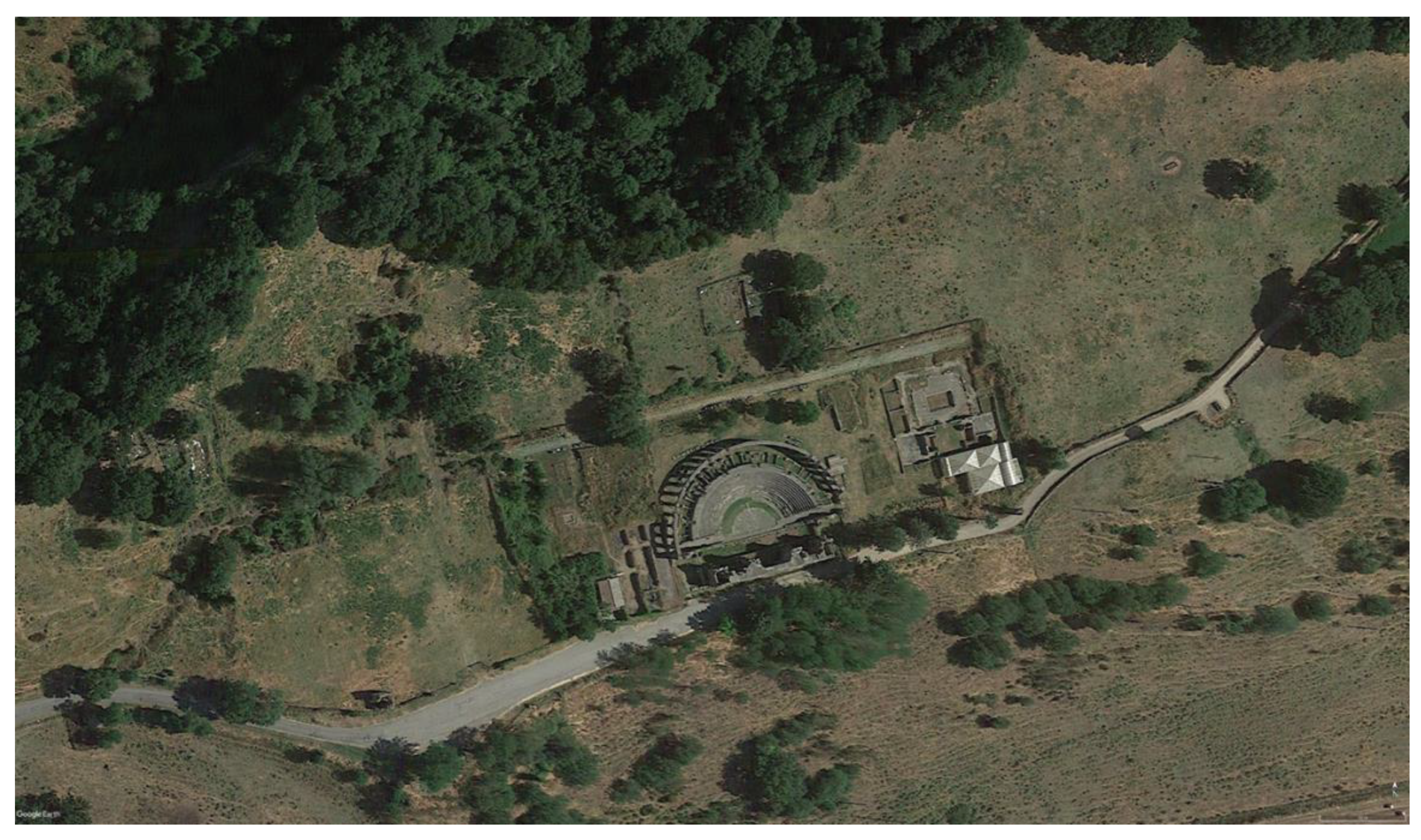
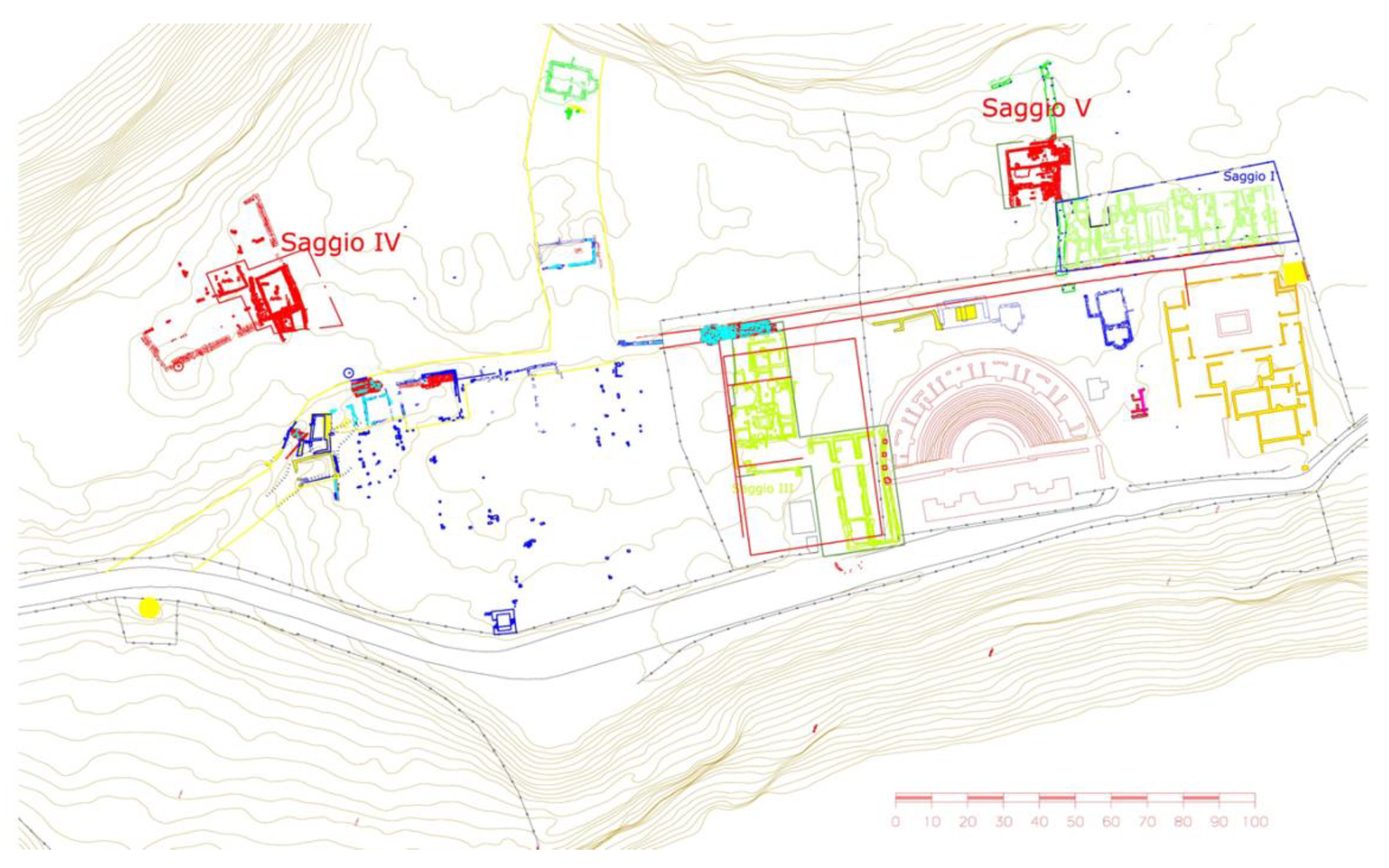
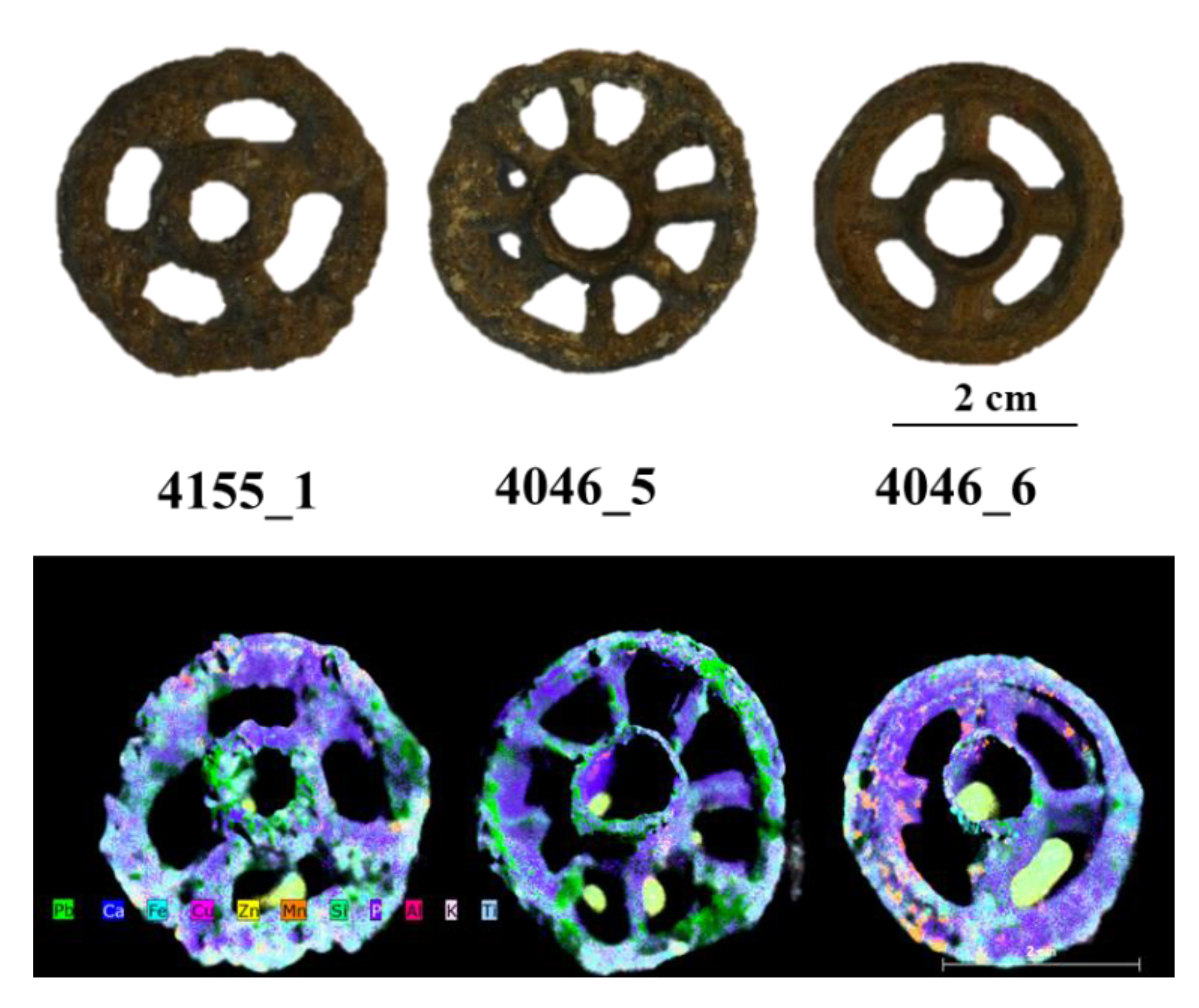
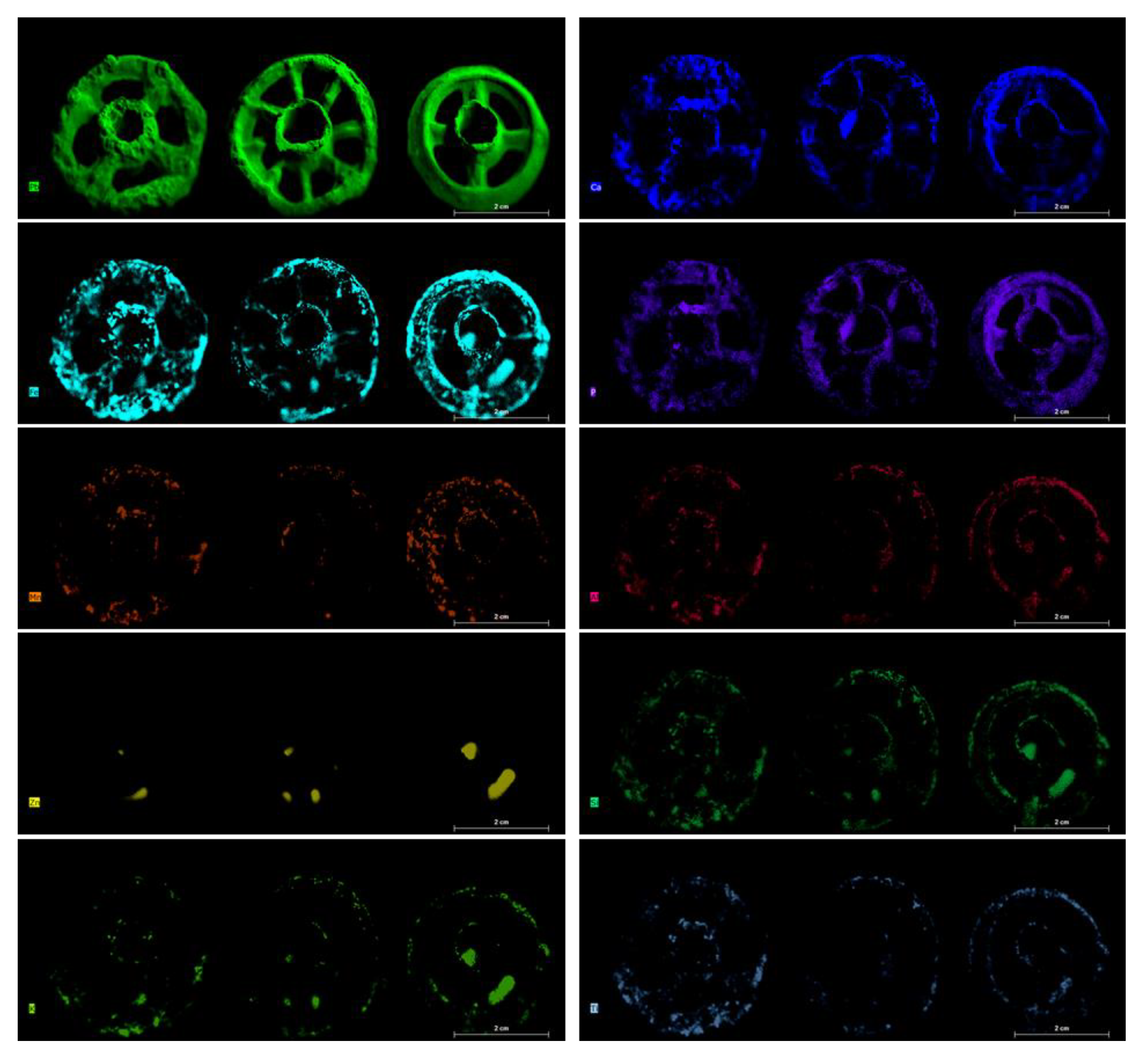

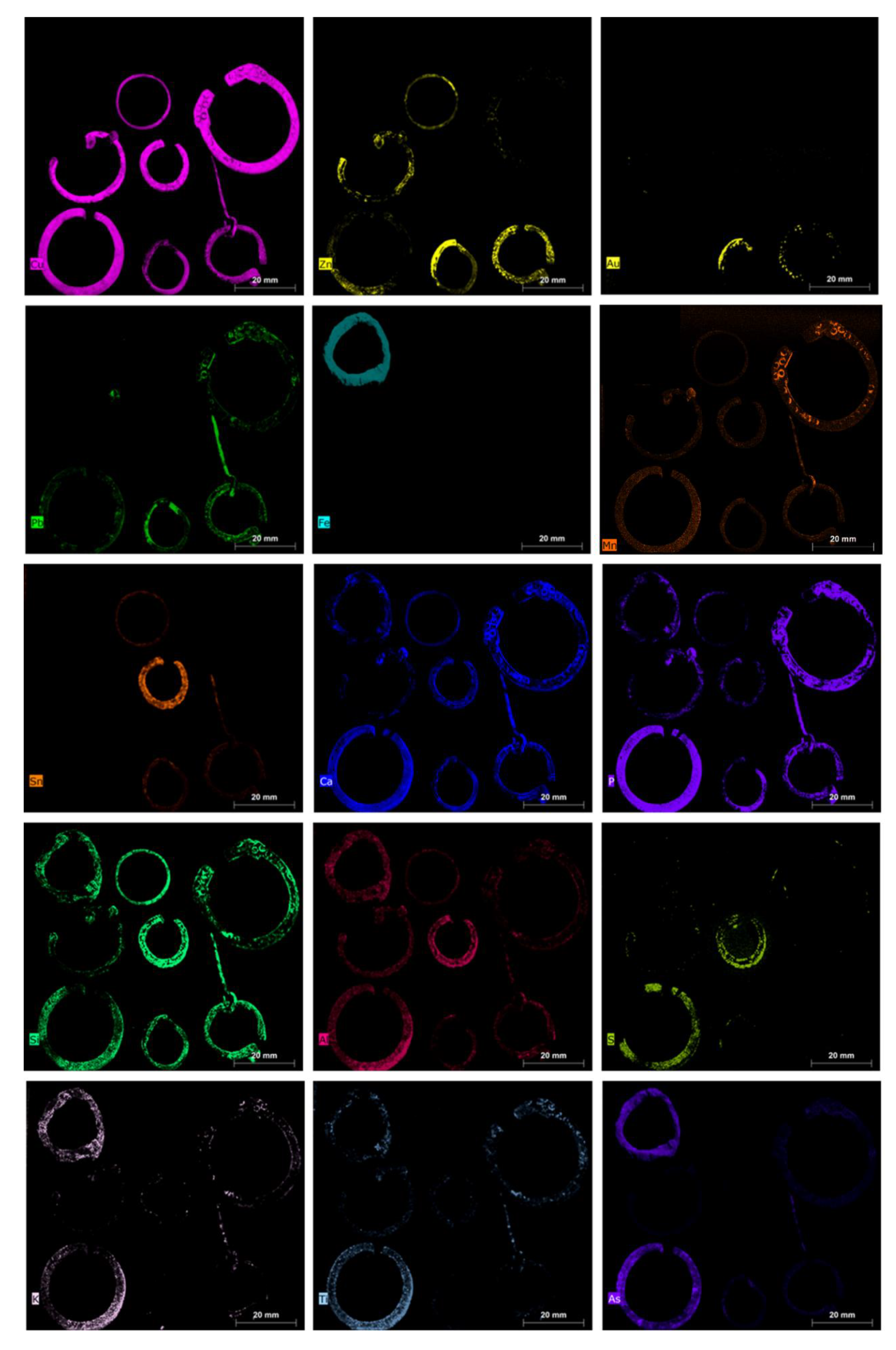
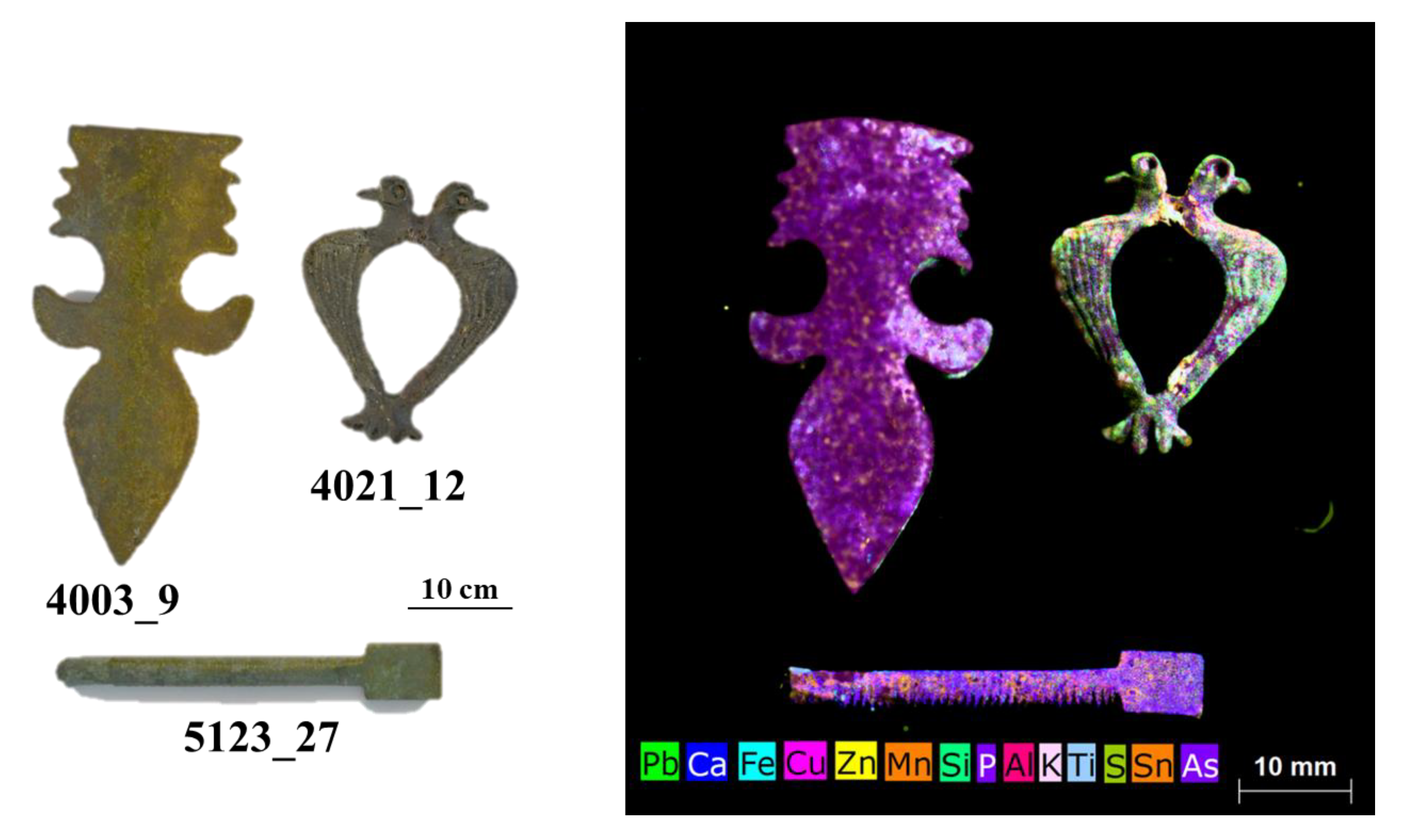
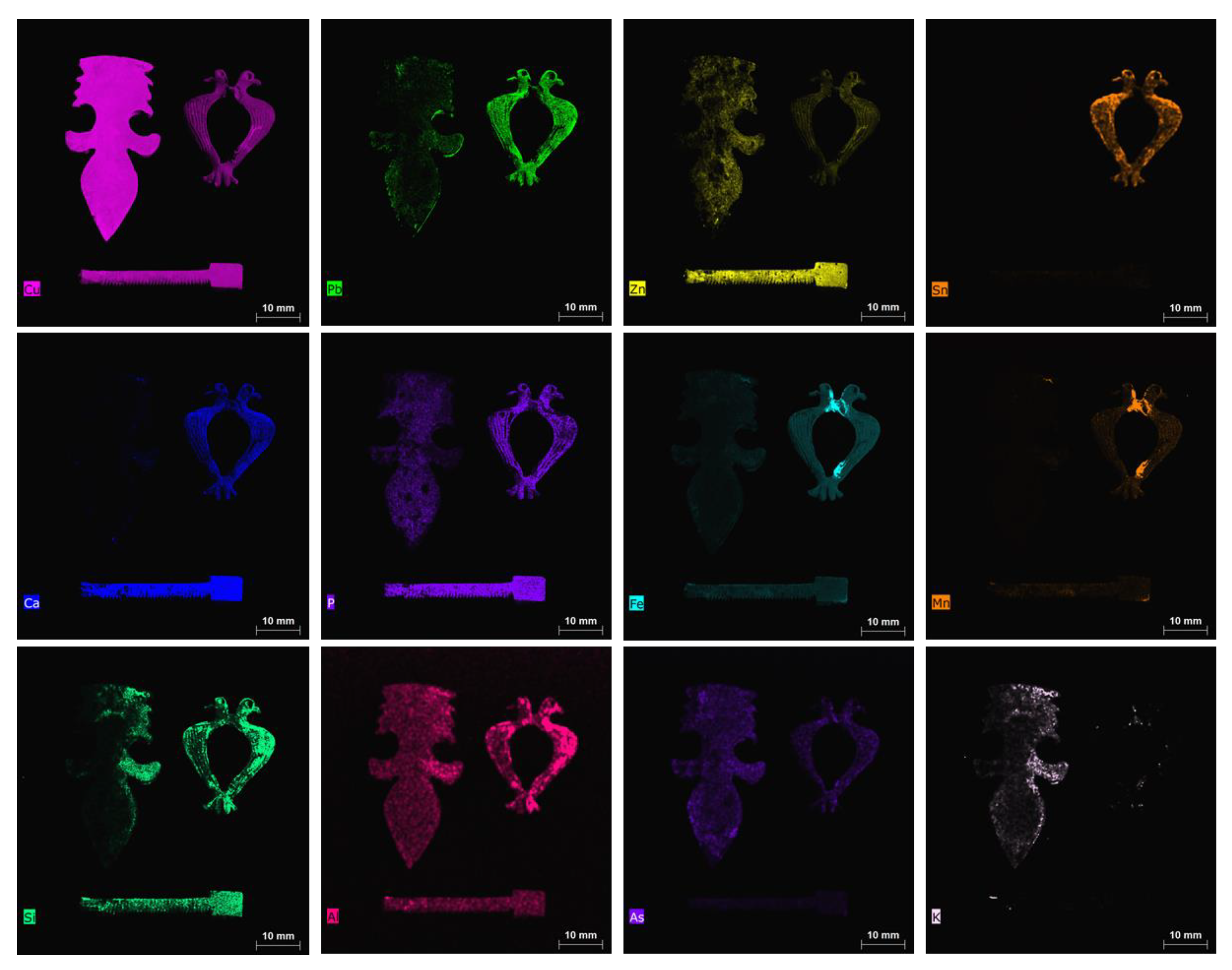
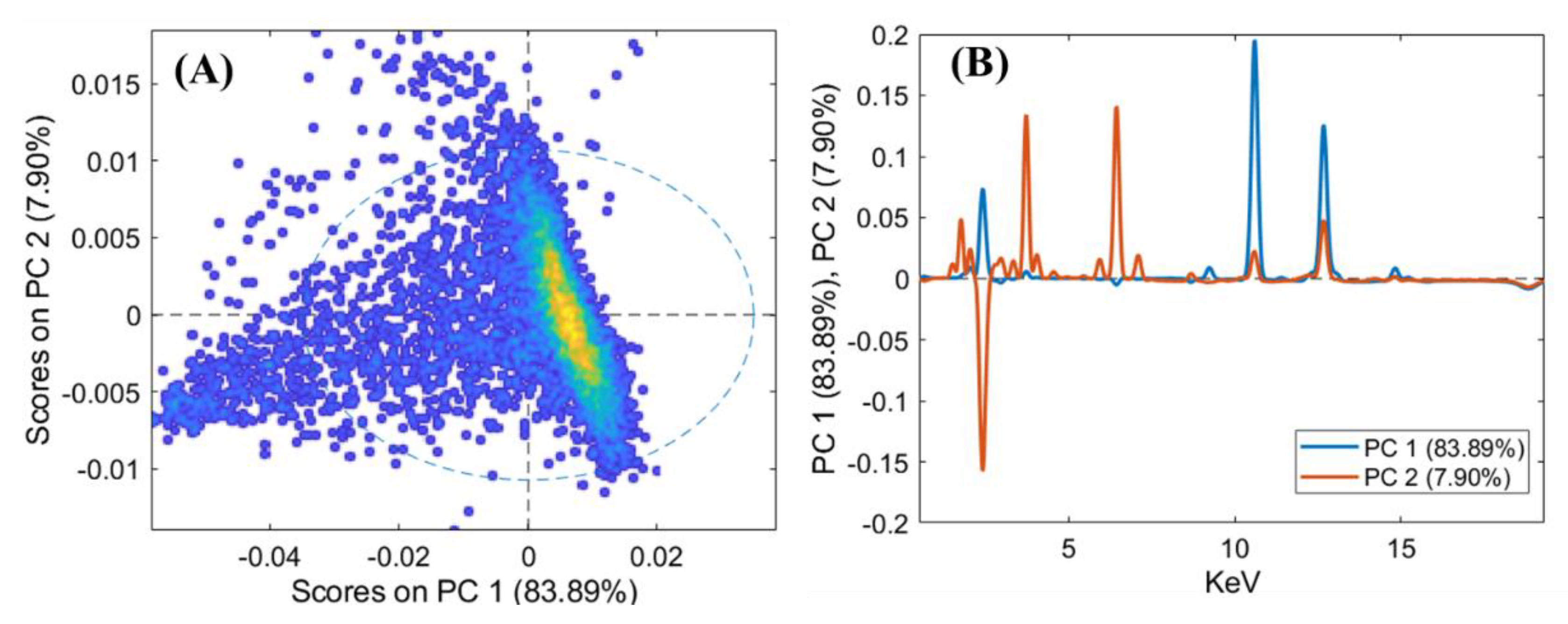
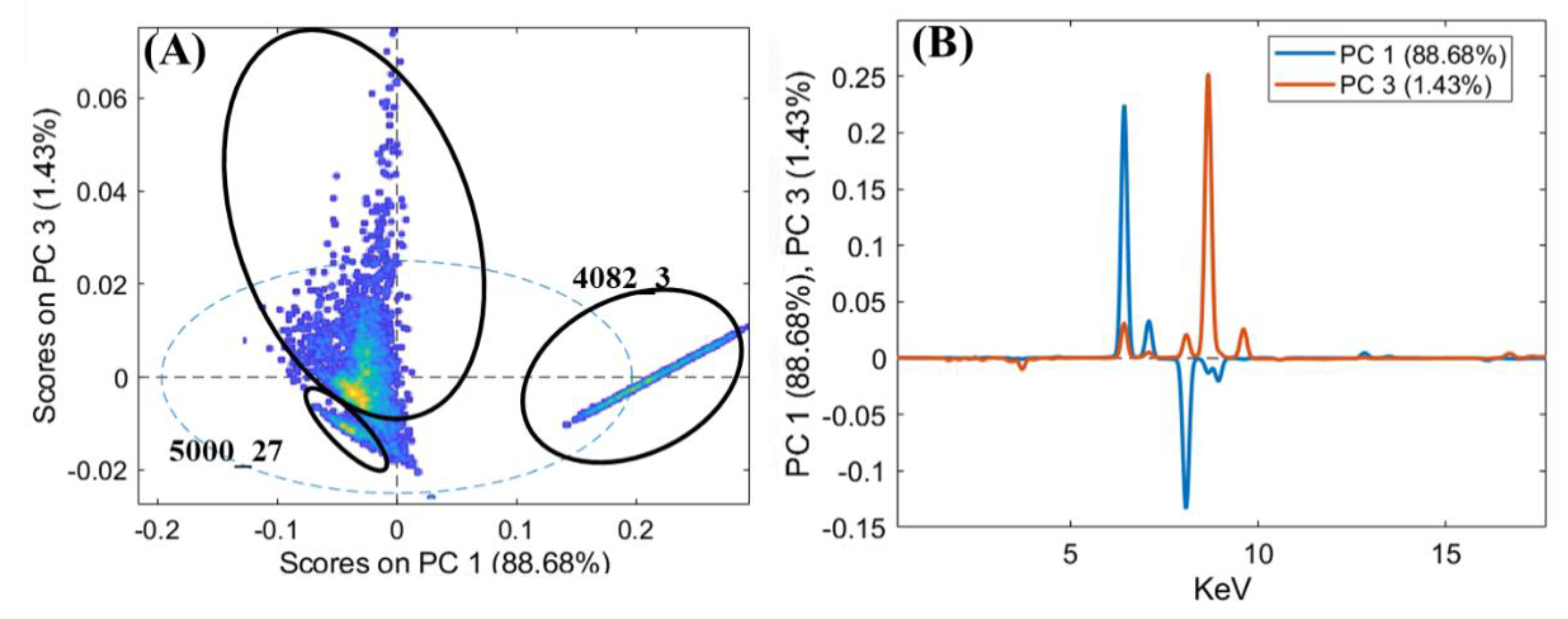
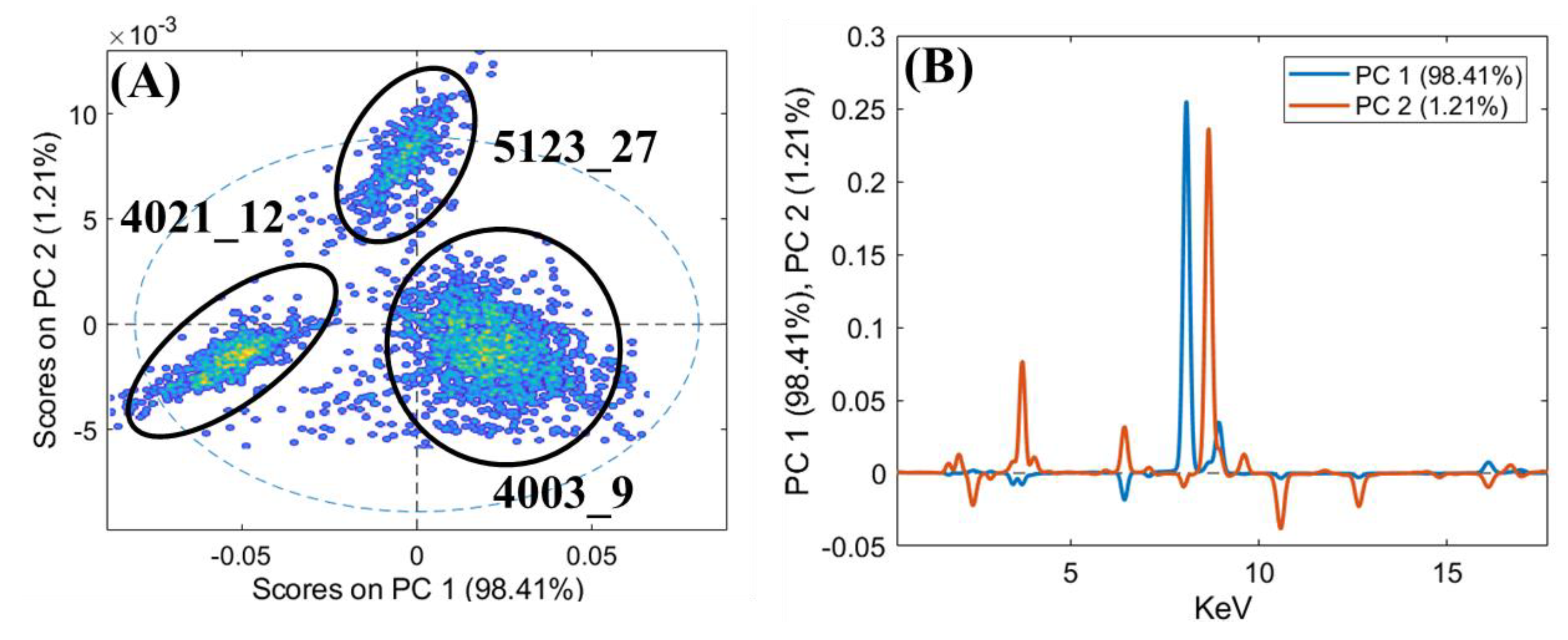
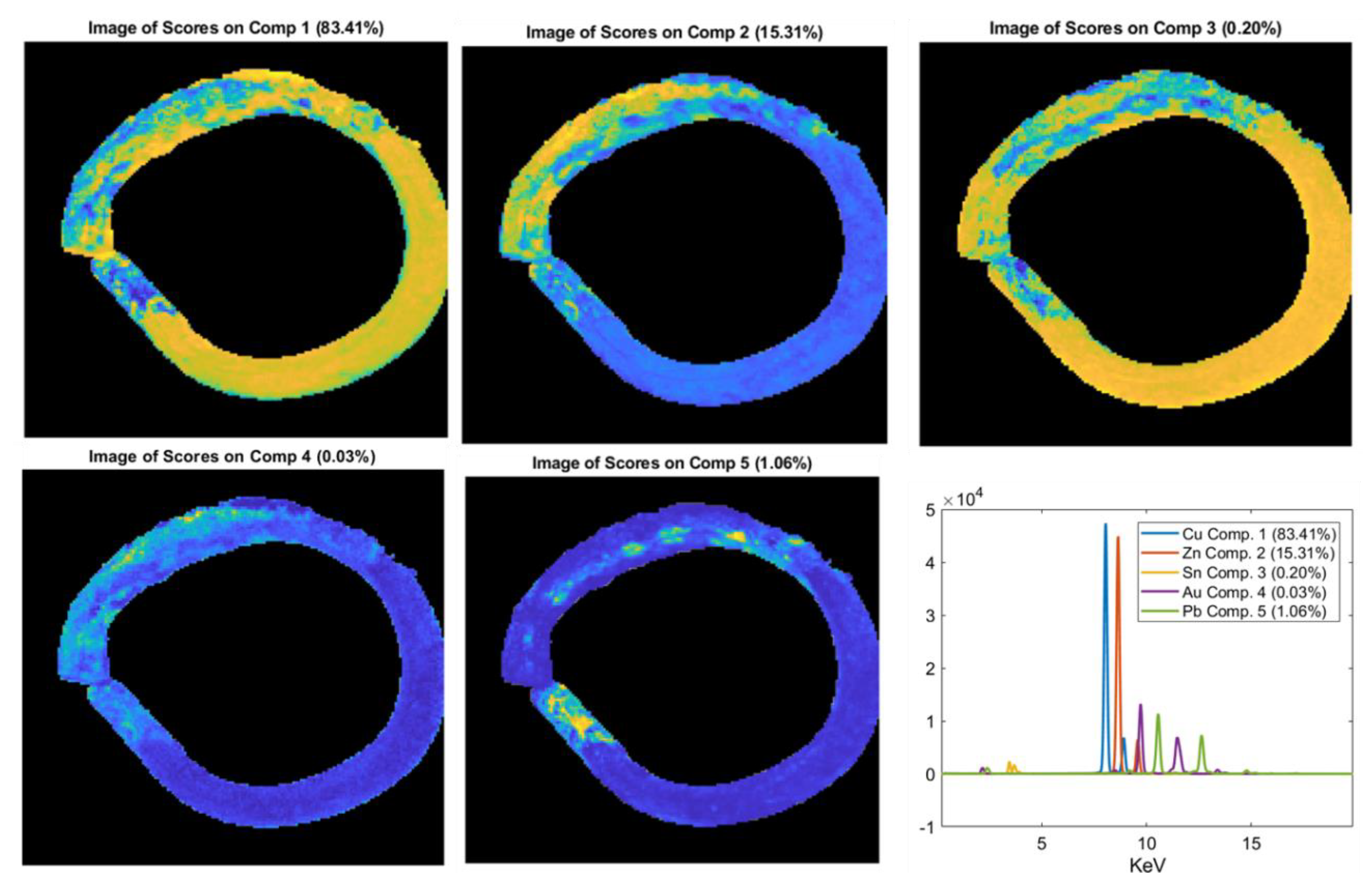
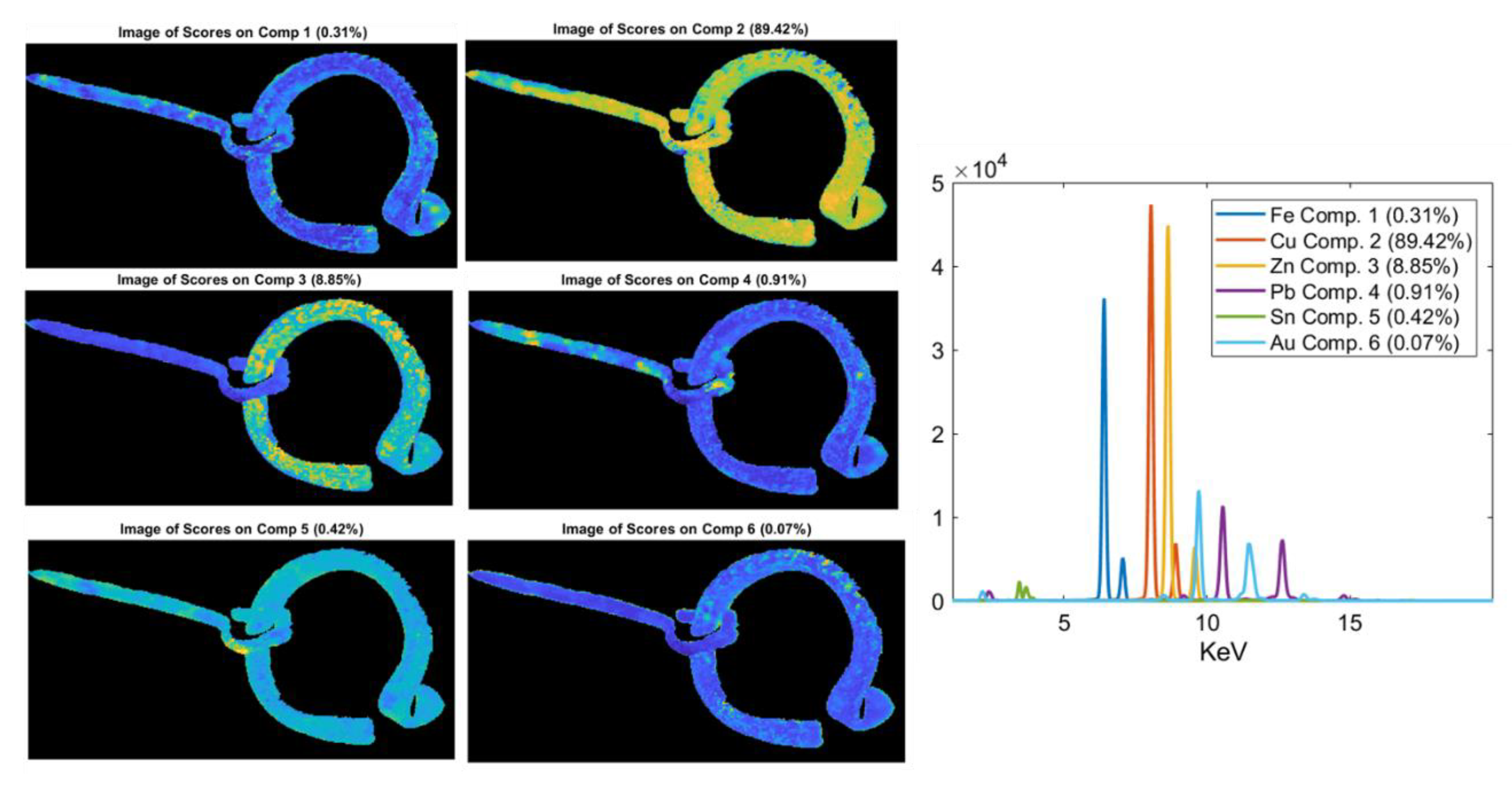
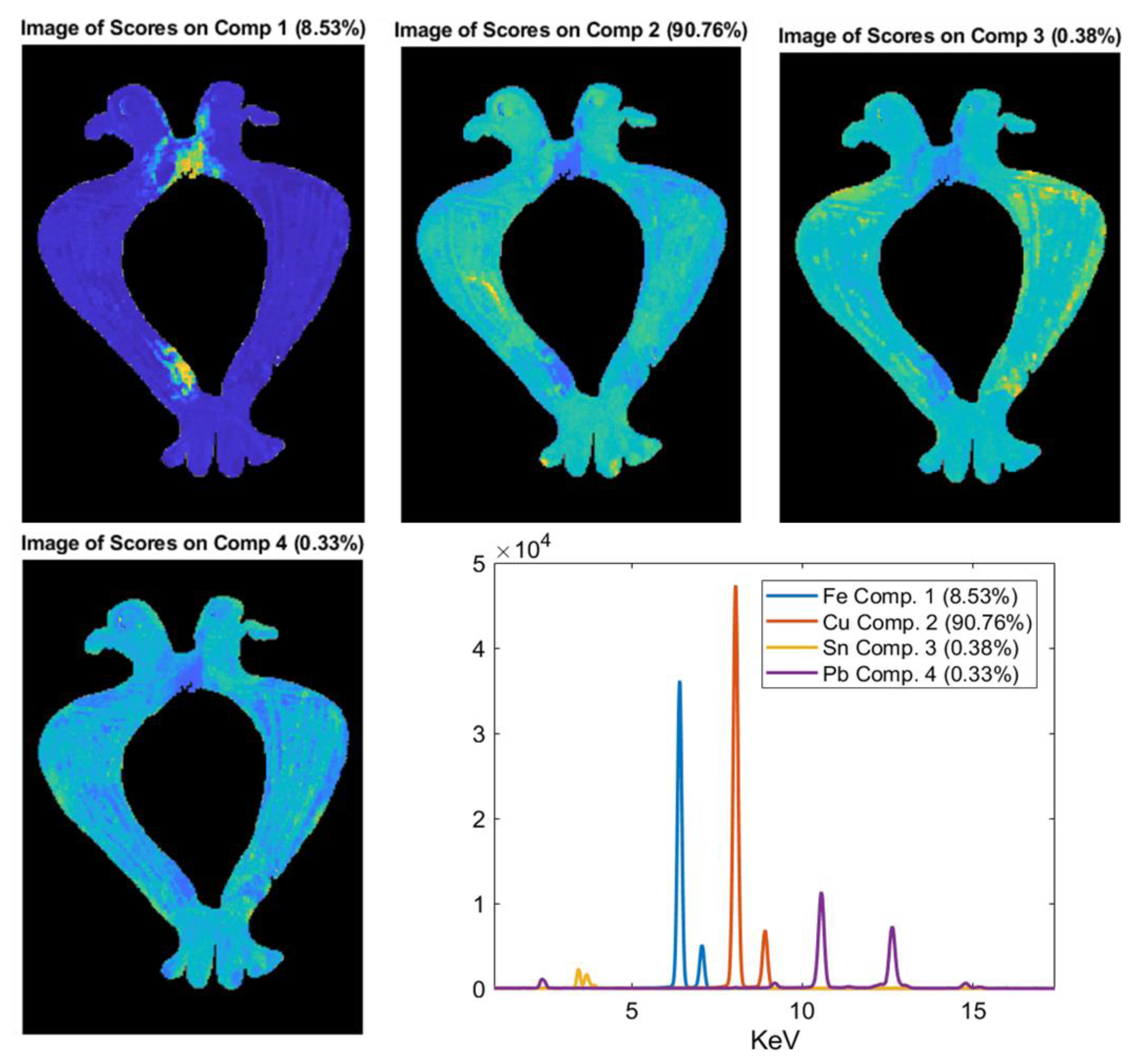
| Stratigraphic Unit | Area | Inv. Nr. | Description | Typological Dating of the Item | Dating of the Stratum |
|---|---|---|---|---|---|
| 4003 | L 8 III d | 4003_7 | Clothing accessory, fibula | VI–VII | XI–XII |
| 4003 | L 8 III a | 4003_9 | Applique, furnishing object | — | XI-XII |
| 4021 | L 7 II a | 4021_12 | Clothing accessory, zoomorphic fibula | XIII–XIV | Late Middle Ages |
| 4025 | L 8 III b | 4025_4 | Clothing accessory, fibula | VI–VII, and early XII | XI–XII |
| 4046 | L 7 II a | 4046_5 | Ornamental jewellery, talisman or toy | From the Roman to the Medieval period | XI–XII |
| 4046 | L 8 III d -L 8 IV c | 4046_6 | Ornamental jewellery, talisman or toy | From the Roman to the Medieval period | XI–XII |
| 4082 | L 8 III c | 4082_3 | Ring | Middle Ages | XII |
| 4155 | L 7 I a | 4155_1 | Ornamental jewellery, talisman or toy | From the Roman to the Medieval period | XII–XIII |
| 5000 | L 18 IV c | 5000_27 | Clothing accessory, fibula | VI–VII, and early XII | Humus and XII–XIII |
| 5050 | L 18 I b | 5050_4 | Clothing accessory, fibula | VI–VII | Middle Ages |
| 5079 | L 18 I b | 5079_5 | Ornamental jewellery, probable earring | — | XII–XIII |
| 5085 | L 18 I d | 5085_6 | Ornamental jewellery, earring | Roman period | XI–XII |
| 5123 | L 18 IV d | 5123_27 | Spatula for cosmetics | Late III century | XI–XIII |
| 5123 | L 18 IV d | 5123_45 | Clothing accessory, fibula | VI–VII | XI–XIII |
© 2020 by the authors. Licensee MDPI, Basel, Switzerland. This article is an open access article distributed under the terms and conditions of the Creative Commons Attribution (CC BY) license (http://creativecommons.org/licenses/by/4.0/).
Share and Cite
Capobianco, G.; Sferragatta, A.; Lanteri, L.; Agresti, G.; Bonifazi, G.; Serranti, S.; Pelosi, C. μXRF Mapping as a Powerful Technique for Investigating Metal Objects from the Archaeological Site of Ferento (Central Italy). J. Imaging 2020, 6, 59. https://doi.org/10.3390/jimaging6070059
Capobianco G, Sferragatta A, Lanteri L, Agresti G, Bonifazi G, Serranti S, Pelosi C. μXRF Mapping as a Powerful Technique for Investigating Metal Objects from the Archaeological Site of Ferento (Central Italy). Journal of Imaging. 2020; 6(7):59. https://doi.org/10.3390/jimaging6070059
Chicago/Turabian StyleCapobianco, Giuseppe, Adriana Sferragatta, Luca Lanteri, Giorgia Agresti, Giuseppe Bonifazi, Silvia Serranti, and Claudia Pelosi. 2020. "μXRF Mapping as a Powerful Technique for Investigating Metal Objects from the Archaeological Site of Ferento (Central Italy)" Journal of Imaging 6, no. 7: 59. https://doi.org/10.3390/jimaging6070059
APA StyleCapobianco, G., Sferragatta, A., Lanteri, L., Agresti, G., Bonifazi, G., Serranti, S., & Pelosi, C. (2020). μXRF Mapping as a Powerful Technique for Investigating Metal Objects from the Archaeological Site of Ferento (Central Italy). Journal of Imaging, 6(7), 59. https://doi.org/10.3390/jimaging6070059











